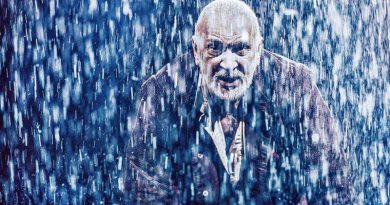Marc Brenner photography interview: Dana Rufolo
Dramatic Theatre Photography:
Marc Brenner interviewed by Dana Rufolo.
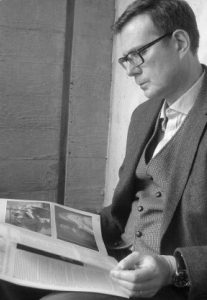
Marc Brenner peruses Plays International & Europe during this
interview at the National Theatre.
Photo credit: Axel Hörhager.
It seemed just a random decision of ours, based on practicality, that Marc Brenner and I agreed to meet for this interview in October 2017 on the South Bank of London in the café of the National Theatre. And yet as we talked amid the hubbub of people eating gourmet hamburgers while clanking their dishes, I learned that this very Denys Lasdun-designed building had been the place where Brenner developed a soft spot for the theatrical world which led, in a sinuous and roundabout way, to his becoming a theatre photographer. And a highly successful one, at that.
His instinct for capturing the dramatic moments in a production has become greatly and deservedly appreciated. He was currently working on a mammoth project: Disney’s Frozen. He’d photographed the out of town try-outs in Denver, Colorado and in early 2018 he journeyed to New York on a two-month assignment to photograph the Broadway production; he was hired, as he told me, “to take all the behind the scenes photographs, capturing the making of the set, costumes and, of course, the rehearsal and technical preparations”. In addition, he photographed the Michael Grandage-directed Hughie by Eugene O’Neill when it was produced at the Booth Theatre on Broadway in 2016. Just announced, he is the photographer in charge of the production shots, as well as rehearsal and behind the scenes images, for the Jamie Lloyd Company’s “Pinter at the Pinter” that presents all of Harold Pinter’s one-act plays. “
I told Marc that I had just seen James Graham’s Ink (directed by Rupert Goold) in the West End. It turned out he had photographed the show twice, first when it was at the Almeida and then at the Duke of York’s so as to include photos of a couple of new cast members. This led to a discussion of favourite theatre spaces to photograph in; as did my interview with photographer Johan Persson. Marc Brenner has definite preferences. Dana Rufolo.
What is your favourite theatre space, then?
I adore the Almeida. It’s one of those theatres where they create productions to truly fill the space, if you know what I mean. It’s so playful. With the dimensions of the building, with the dynamic of what they put on stage, with the playfulness, the experimentation of the design, always being true to the play itself, never stretching it out of shape.
There are other theatres where it turns out well, but I think the Almeida is a great place to shoot in. And the Olivier (the main stage in the National Theatre). It’s a very challenging place, because of course it’s big and massively deep. Capturing the dynamic between characters who could be standing way apart having a conversation across a vast amount of neutral empty space can be a little difficult because then you’re usually having to go for scenery, and you’re sitting, hoping, waiting for the big group shot.
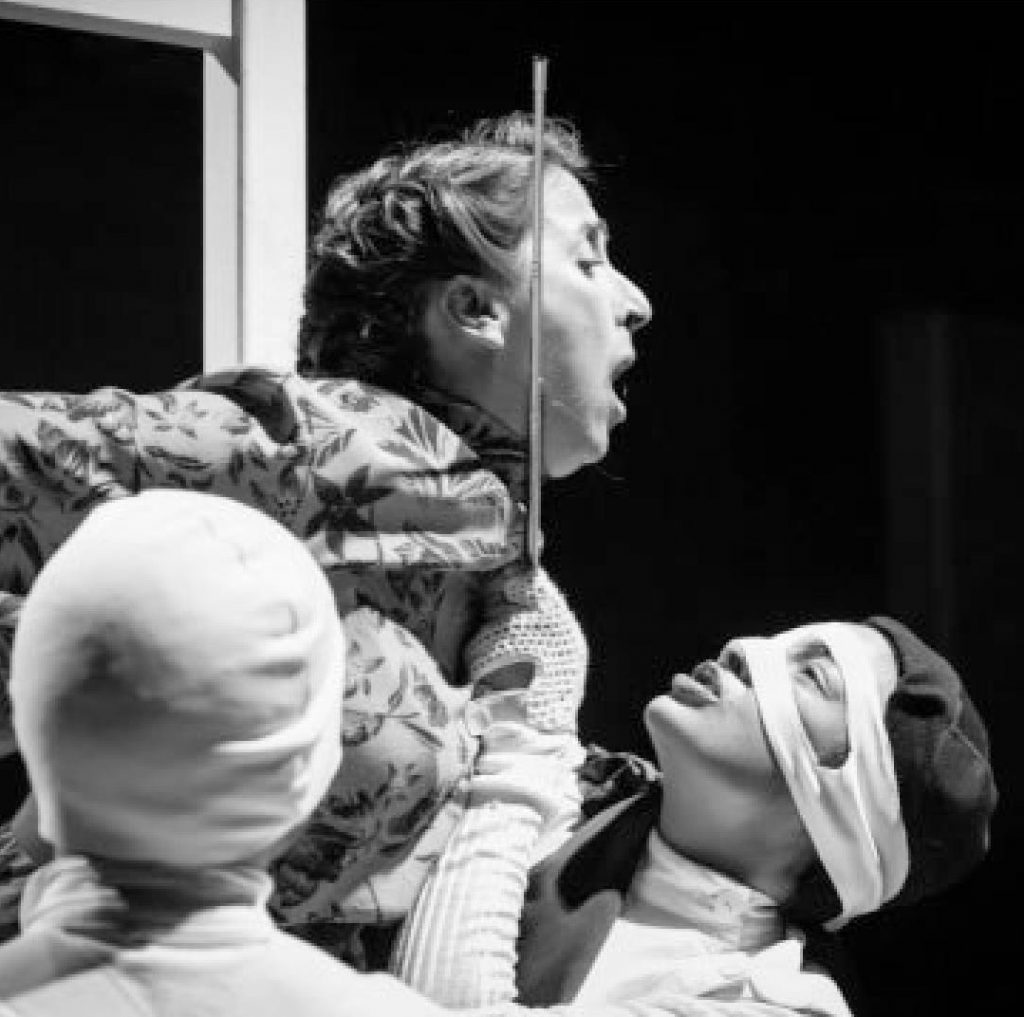
The ensemble in A Clockwork Orange at Liverpool Everyman.
Photo credit: Marc Bremmer.
And how do you solve that at the National Theatre’s Olivier stage?
Sometimes I have, and sometimes I haven’t. There was a production a few years ago which was an adaptation Emil and the Detectives where they just swamped the stage with actors. (December 2013, a production directed by Bijan Sheibani of Erich Kästner’s 1928 children’s novel, adapted for the stage by Carl Miller). I think they had something like 50 people on stage of which 30 or 40 were kids, and when you populate a stage with that amount of bodies you play on the theatricality. When you have several levels – not just playing on the floor – then it becomes much easier to photograph. As opposed to another show where there was very little set, and there were conversations between people that were picked out in the spotlight here and there … then you have to think, “Huum! It’s portrait time really”. You just have to stop going in.
Amadeus, that’s another one where there was plenty of movement, of action, of clustered bodies although a kind of focused energy which invites you to be just very playful with photography. There were so many different styles and of course they had an on stage orchestra they were acting around.
Like with Brecht, the recent Threepenny Opera at the Olivier?
It wasn’t just a couple of musicians strolling round like minstrels. It was a full orchestra, about twenty or thirty people, and that’s a gift for a photographer. There’s not an awful lot a photographer can do to solve these problems. It depends what the production is, it depends what’s put in front of you, it depends on how much movement and access you have.
Tell me about your history. Why did you fall in love with theatre?
I started off as a kiddie actor in this very building.
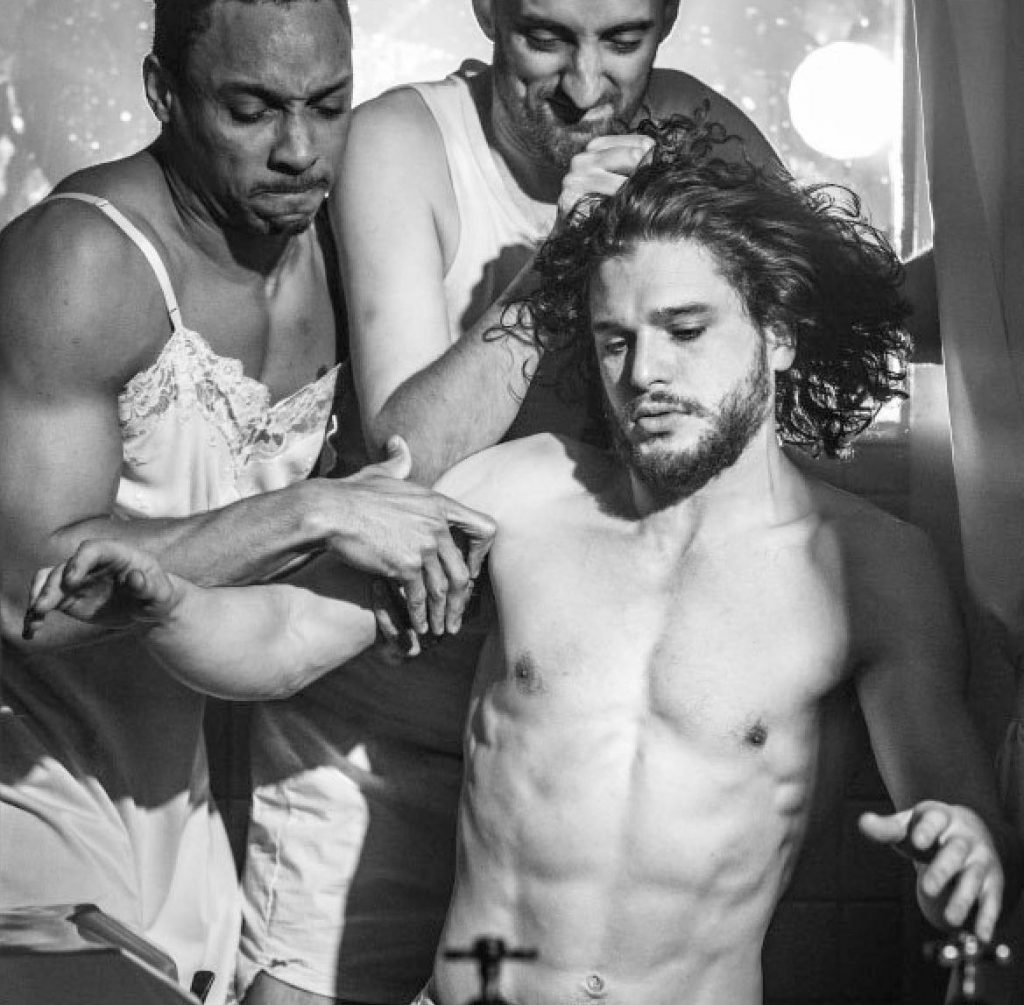
Kit Harington, Tom Edden and Craig Stein in Doctor Faustus
at the Duke of York’s Theatre.
Photo credit: Marc Bremmer.
You’re a Londoner by birth?
Yeah. I was in two plays at the National Theatre when I was 13. It was a sheer fluke. I belonged to a youth club and played football. An agent called up and said, “We’re looking for a fat boy with blonde hair”. I was completely wrong for it, but I went anyway. I got sent down the hall in this very building to another production where Howard Davies was directing the show, and a week later I was in the rehearsal room.
Times have changed. When I was a kid, you had the run of the building. Kids don’t see anything now. They’ve got their own toilets, they eat in a separate place. I played in Life of Galileo (Bertolt Brecht’s play, at the Olivier in 1980) and The Shoemaker’s Holiday (Thomas Dekker’s play, at the Olivier in 1981), which was less of a success. There was a book about behind the scenes at Galileo called Theatre at Work by Jim Hiley (Routledge & Kegan Paul, 1981); he used to write for the Telegraph.
I did that for a couple of years. When you’re a youngster, you think, “Oh, that’s what I’m going to do”. I got very quickly bored of it, even while I was doing it. It was exciting, and then rather disastrously for an actor, I asked myself, “Why are you doing this every night; why would you do the same thing again and again … especially when you’re 13 or 14?” So I guessed quite early actually that I didn’t think acting was going to be for me. I actually moved into journalism. After school and college, I became a journalist.
All the way through I was taking photos; it was my hobby; it was no more than that; it was something that I enjoyed the way I enjoyed very much in the early days playing with video as well – VHS. You had to carry the VHS recorder with you to actually film something, friends and all that sort of stuff. That was all that there was then, so I never thought of the connection between photography and theatre.
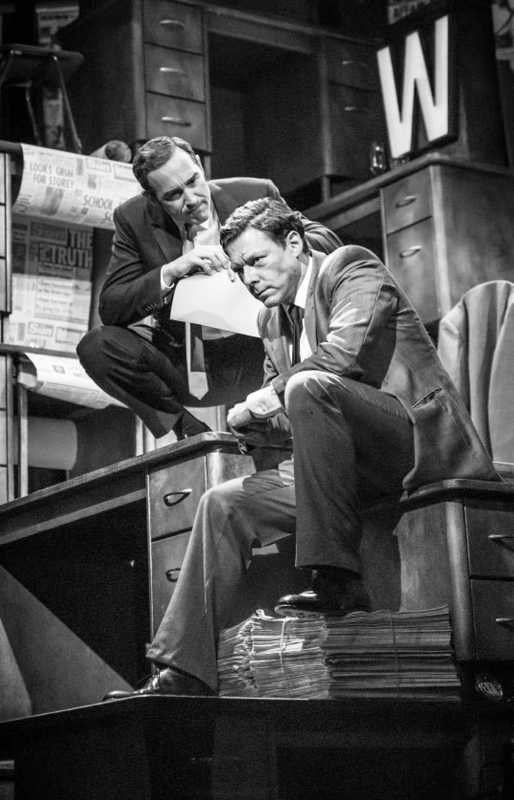
Bertie Carvel and Richard Coyle in Ink, Almeida Theatre
and Duke of York’s Theatre 2017-18.
Photo credit: Marc Brenner.
I was a local newspaper journalist. After that I moved into business journalism, magazine journalism. I didn’t take any photos while I was a journalist. I had my hobby of photography, I was doing street photography. And then what happened was a friend of mine had a fringe company that used to do plays in pubs, that sort of thing. I started taking a few photos for his company: Strut and Fret. That was in 1995, 1996. I got really interested. I thought I could bring something to that. It was something completely different to what I was doing in the day job. It allowed me access to rehearsals and productions that I hadn’t had for a very long time. I realized how much I had missed it. But I didn’t want to be involved in directing, performing, writing. So, it gave me a early interesting kind of short access: you come into a rehearsal room, you watch, observe, you shoot, and then you leave. You’re not tied to the project for months; you’re dipping in and then going on to the next one. So I didn’t have all the things I used to get bored with, which was the idea of repetition, doing the same thing. I realized photography gives me exactly what I want — it’s very, very concentrated and varied.
So I’d been doing journalism for a long time since the late 1980s, and I finally quit that to go full time with what I’m doing now …
When was that?
Eight or nine years ago I moved over to full-time photography. I never regretted it for a day.
How did you get started? Were you working on word of mouth?
Word of mouth, relationships, and past work: that’s all it is. All we’ve got to trade on is: did we do a good job, do we have a good portfolio. If we didn’t upset anyone – actors, if we didn’t hit anyone or anything like that – you’re potentially going to be asked back again. I don’t think any of us do any active marketing any more. I don’t think we need to. The interesting thing about the UK – the production photography market – is that you have relationships with two types of contact.
One is with the director. Each director will have a photographer they prefer to use. Or the marketing department of the theatre itself or the producer. It’s one or the other. Usually the director has a lot of sway, so if you’ve got a relationship with a director who’s around a lot of producers if they say I want him or her (as my photographer), they’ll usually get that person. That’s how it works. That’s how we remain employed. You trade on your past work. Did you do a good job for them? I guess if you don’t do a good job, you’ll know about it fairly quickly.
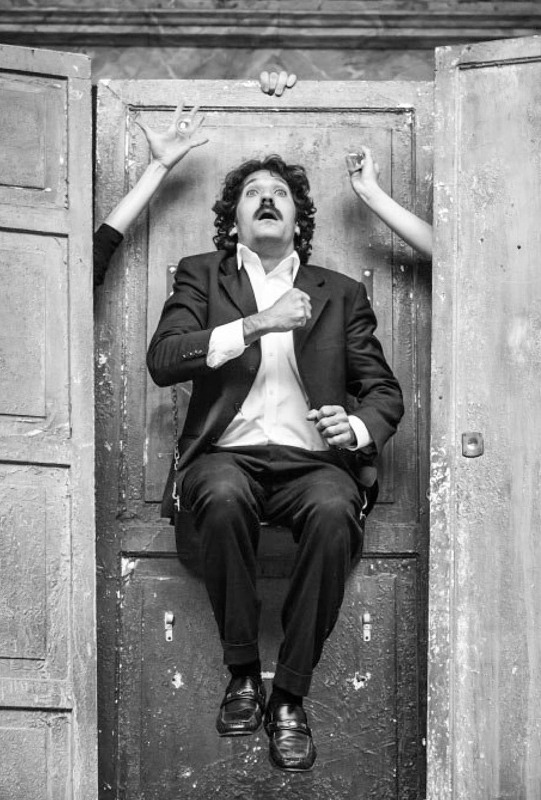
Julius Caesar. I Termini Company Benevenuti / Lungta Production.
Globe to Globe season.
Photo credit: Marc Brenner.
You say “we”. You’re very conscious of the fact that you’re a group, but you don’t have an association of theatre photographers – or do you?
No, there isn’t one really. I knew a couple of other photographers on the first job that I did when I went full time. It was a fantastic project for Shakespeare’s Globe. It was called “The Globe to Globe Season”. They did every single Shakespeare play. And each play was produced by a different country. So 37 plays, 37 different countries. (The Globe to Globe Festival ran from 23 April to 9 June 2012 as part of the World Shakespeare Festival. The key focus was on the fact that the performances were in 37 different languages.) Each country had a different play.
It was only for about four weeks. They got one dress rehearsal and then they went straight on. There was myself and four other photographers. Each of the five of us photographers had five or six shows. We covered the back-stage preparations and the production itself.
Where did those photos go?
Funnily enough, there is a website (http://yearofshakespeare.com). If you walk down the South Bank (east) ten-twenty minutes to where the Shakespeare Globe Theatre is, they’ve got an exhibition space, and they’ve still got all the photos up. I think there’s about thirty, forty of them, the best. Each of us gave our five or six favourite photos. They’re beautifully framed.
Now if I was going to identify your style, it is that you have a wonderful sense of what is theatrical. When you show characters together, it is not just an encounter; it’s a very theatrical encounter. Over and over again you capture the theatrical moments, dramatic moments. Is that an aesthetic that you consciously worked on or is it your personality?
I suppose you have to remember that what you see is always not necessarily the choice that I would have chosen. Funnily enough, all of us want that sort of a moment – a glorious scene change or the glorious craziness of an Ink scene change. I quite like also cooler moments, whether it’s introspection, quietness, or trying to catch a thought. Action is just making sure you’re shooting fast enough. And there’s sometimes luck involved in the split second of the eyes connecting, especially if there’s been something crazy going on. Getting a photograph of somebody thinking, where you think that you can read what’s going on in their mind without making a face – I love them … I love that − beautifully caught in light. There’s something quite cold. Rather than thinking, “Oh you’re in there, you’re in the moment”. I also quite like photographs that are quite distant as well, almost graphic.
…but still telling a story?
That’s right.
So you prefer the actor not as actor but as an agent of action?
That’s right. Sometimes there’s as much going on with the actor that’s listening as with the actor that’s talking.
Were you doing this in the old days, before becoming a theatre photographer, when you were doing your street photography?
Yeah.
There’s something quite voyeuristic about it, isn’t there, actually. How do you handle the voyeuristic elements – in this photo for instance (at Shakespeare’s Globe)? What’s going in in your head when you took the photo? (Thalissa Teixeira as Emilia inOthello at the Sam Wanamaker Playhouse, in Plays International & Europe, Summer 2017).
Well, you have to remember that in this particular theatre space there is one consideration that overrides everything else, and that is technicality. This is in the Sam Wanamaker Playhouse. It’s lit only by candles, and I have to be quite honest with you − every photographer who is in that space is thinking, technically, “How do I get the shot?” It’s very still … it’s a very, very challenging space.
They don’t give you light?
No, no absolutely not. We get the candles. So moments like this one where the candles were on the floor – this is quite handy because the candles light her face, so it’s fine. I don’t know if you’ve been there, but there are big candelabras, and if they’re right at the top, it’s a very soupy, horrible, grey effect.
So I can’t give you any more creative answer than that, but this particular space is all about getting it right technically. Photographing movement in that space is impossible. So the quieter moment, the still moment in that space is better. That’s what that space is about. Voyeuristically, you know the difference between street photography and rehearsal photography is that you’re dealing with actors. They’re comfortable with the relationship, they know how to behave when the camera’s in the room – not looking at it and seeming to be oblivious to what’s going on whether they’re in a rehearsal moment or just sitting on the side waiting. So there’s a complicit agreement between the photographer and the actor. It’s not a natural thing but everyone knows, everyone understands how it works. “Candid” in a rehearsal room is quite difficult.
So I would suspect from what you’ve just said that you still do photography which is free of restraints – that you still have a hobby of photography and that you do very candid photos.
Not as much as I used to, actually. But I still do take photos that have nothing to do with work. The kind of photos I take now – street stuff – keep up my reaction skills.
You’re trying to not lose spontaneity?
Yeah.
Do you have a work schedule? Do you work Monday to Friday?
I work all the time. For press departments and production departments it’s overnight delivery now. You used to have a little bit of breathing time. If there’s a dress rehearsal at one o’clock in the afternoon, in some cases they’ll want to see the photos that night. Then once they’ve made their selection you finesse and polish. You can sometimes argue, how about this one and not that one, but you’ll have an initial delivery of photographs out of which they’ll make a selection. I work Saturdays. Ink at the Duke of York’s they had a dress Saturday and then they had a preview that night. They want to see those photographs quickly. This is the biggest change that has happened.
Do you give them all your photographs or just the ones you think they will want to see?
I’ll never try to second-guess a marketing department. I’m delivering anywhere between 150 and 200 shots, all of which I would be happy for them to use – so 200 good shots for them to choose from. I’m taking more than 1,000.
What do they do with these photographs?
They’re using them as poster material. Fliers, social media… it’s out, out, out.
We’re allowed to use this picture on the cover (Plays International & Europe Winter 2016) because the press department has allowed it.
Sure.
But isn’t there copyright? Owned by you?
It’s a grey area. Obviously the production photographs − the press department − can distribute those as they see fit. If you were to use a photo for tee-shirts that you printed out to sell, then we would have a different conversation about that. If you’re using it for a separate venture, then the copyright is still mine.
But I suppose you aren’t concerned with anything but the production when you are photographing? What are you thinking about then?
You know when you’re out of sync with the shots … sometimes you’re slightly behind and you’re missing a shot. Or you feel, “Yeah this is going well”. I find myself almost weirdly anticipating where the next moment – the next shot – is. If you start thinking, “Where is the shot?” you’re doomed because then you’ve just been trying to second guess it, and by the time you’ve gotten your camera pointed in the right direction, there is nothing there. So I think it’s just trying to capture the rhythm of the show in the way that you yourself move around.
It seems like your creativity is associated with almost a kind of dance with the camera …
I don’t feel like I’m creating. I just feel like I’m doing a job. The creating is what I feel: that I’ve been honest with what I shot, that I’ve been true to the special and emotional intention of that production. I don’t say the intention of the director; I say production, because it’s the direction, the acting, the lighting, and the set design. Where I get disappointed is when I shoot and one of those things doesn’t manifest, like if I didn’t manage to represent it in a way that is true to its scale and dynamic.
What kind of camera do you use?
I use two Canons. A Canon 5D Mark IV and a Canon 5D Mark III. I’m thinking about changing, because there is a big thing that is happening, and that’s a call for silence. My cameras aren’t silent. Some photographers are starting to use silent now. Technically that’s becoming the thing now.
So, that’s where the future is heading. And for the past − what kind of changes have you noticed during your lifetime, or at least your career, in the art of theatre photography?
There’s a change that happened in English photography in the last 20, 30 years. If you look back at photographers like John Haynes, Zoë Dominic (who photographed the production I was in when I was in a kid,The Life of Galileo), back in those days, as I remember, those photos were barely used for press purposes. In fact as I remember the only magazine that used them was Plays and Players. This is 1980. I remember that for the reviews that came out for The Life of Galileo, I reckon no more than ten per cent had an accompanying photograph. And it was a five-star review, it was a glittering production, and they didn’t have any accompanying photos. The photos were never used again. They were for archival purposes. Now, the photography spearheads marketing campaigns.
But something also happened with style in photography. If you look back at Haynes and even though he’s still around someone like Nobby Clark, they worked in black and white. And also a wonderful photographer who died in 2004, Ivan Kyncl who was Czech and started off as a war photographer – so he started off photographing combat – he had a rough, dirty, explicit, black, grainy, blurred amazing style. Now it’s all about colour, but it’s more than a colour thing − it’s about fidelity. It has to do with camera technology; it has to do with what a production photo is supposed to look like.



